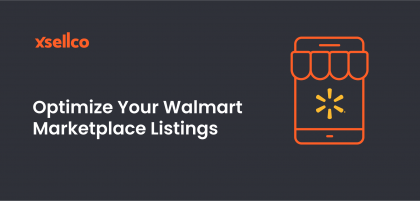Mobile sales Optimization for your business
It’s the New Year, and with a New Year comes an abundance of white noise in eCommerce. Many blogs are underwhelming listicles of eCommerce predictions for 2017. Forget the lists and let’s focus on one thing that’s essential for your business in 2017 – mobile sales and optimization.
The mobile Commerce or mCommerce market currently accounts for 34 percent of all global eCommerce transactions. The growth of mCommerce is predicted to accelerate 200 percent faster than the growth of the entire eCommerce industry in 2017. The future of eCommerce is clearly mobile dependent.
As many as 49 percent of smartphone owners in the US buy products on mobile; smartphones have become tools to shop with, and given the evolution of smartphones with larger screens and greater functionality, the buying process is becoming easier for shoppers.
mCommerce growth and consumer expectations
mCommerce has experienced unprecedented growth in the last number of years – mobile sales are set to grow by a further 31 percent in 2017, compared to a growth of just 15 percent of online sales on desktop. It’s only a matter of time before mobile becomes the dominant platform for eCommerce sales.
With the number of mobile sales increasing year on year, it’s clear that consumer shopping habits are changing. A growing business needs to reflect that retail behaviors are shifting towards mobile.
Consumers expect to be able to purchase a product when they’re on the move, from a mobile device. Mobile presents consumers with a fast and easy way to make a purchase. If your website isn’t mobile optimized then your business is overlooking a large proportion of potential sales.
Before I take a look at some practical steps on how to optimize your business for mobile, let’s find out why consumer behaviors have changed and mobile sales continue to increase.
SEO rankings and smartphone users
Google changed its SEO algorithm, what I like to call Mobilegeddon, to optimize mobile friendly websites in 2015. Google values its reputation and seeks to provide users with a smooth and seamless browsing experience.
If your website is mobile optimized then it will be ranked above a competitor in search engine listings. This organic visibility has the power to make or break your company, and if used wisely it can be leveraged as a free and effective marketing tool.
Another major factor that has contributed to the growth of mCommerce sales is the substantial increase in the number of global smartphone users. Since the introduction of the Apple iPhone in 2007 smartphones have been catapulted into mass consumption.
It is estimated that there were 2.1 billion global active smartphone users in 2016. This figure is to reach 2.71 billion by 2019. There are more Google mobile searches than desktop searches worldwide, according to Google.
What can you do to future-proof your webstore? We know that mobile is the future, so let’s take a look at what you can do to ensure that your business is mobile optimized.
5 strategies to optimize your business for mobile
1. A fixed navigation bar
A fixed navigation bar is one that stays in place when a user is scrolling through a website. A mobile friendly website is a priority for consumers, so design is key. Potential customers are browsing on mobile more than they are on desktop. Customers expect an intuitive browsing experience that is tailored to mobile. If not, they will get frustrated and search for one of your competitors.
Encourage browsers to become buyers by integrating a fixed navigation bar on your website. Customers will be able to access key features and view important information as they seamlessly scroll and view products, such as a “search” option, a “checkout link” or an “add to shopping cart” button. Simplify the buying process for your customers so that you can maximize your sales.
As you scroll the navigation bar will follow.
2. Product listings
It’s important to keep your product descriptions short and to the point when you have a mobile audience in mind. You have less display space for product descriptions so use it wisely.
Consumers don’t want to be bombarded with a large amount of text on their mobile screen, so simply provide a brief description of the product. Keep it simple – detail your product name, price, variant option and provide a call to action button.
Customize the description with your brand tone and personality – this will differentiate your store from your competitors. Too much text will take the emphasis off the product. Let your product photos do the rest of the work.
3. Product photos
The quality of your product photos is key to guiding consumers towards the Buy Button on your website. MDG Advertising collated a study of US retail trends and discovered that 67 percent of consumers believe that the quality of a product image is very important in the buying process.
The success of global social giants Pinterest, Instagram and Snapchat, reflect the growing consumer preference for visual content. When it comes to listing your products, you need to engage your audience visually. Content featuring compelling photo imagery averages 94 percent more total views than content without images.
Be sure to select high resolution photos, and position them at the centre of your mobile design. Show the customer the different angles of the product and try to give an impression of texture with close-ups, and scale with comparisons, where possible. Good quality photos will engage your website visitors and help them with that buying decision.
4. Buy Button
It’s vital that the browse to buy process is simple for your customers, so that they can select a product and purchase it without having to search your website. Providing a clear “Buy Button” or “Add to Cart” option on each product ensures that no matter where they are on your website they can easily progress to the checkout.
Webstores like Shopify and Squarespace come armed with Buy Buttons and mobile optimization as standard, and have options for making fast and simple purchases for your customer.
A sticky call-to-action button can be the difference between converting a sale and losing a visitor. Your customers need to be able to scroll and buy seamlessly as they navigate your website.
Make your Buy Button social. Why not add a Facebook store to your page, or set up a Pinterest and Instagram business account? These options can be set up from stores such as Shopify, and will give your products more visibility and reach to a wider audience.
5. Marketplace listings
If you’re a multichannel seller it’s essential to ensure that your product listings are in compliance with the specific marketplace guidelines. While the overall design of your mobile optimized site will be consistent across the board, your product listings on different marketplaces should vary.
On marketplaces such as Amazon, there are specific product detail guidelines and image standards that you should follow. These include minimum and maximum character counts and image specifications. If you do not comply with these rules then you risk having your account suspended. Don’t take any chances, check your marketplace guidelines:
Now we know that mCommerce is the future for eCommerce sales. The first step to mobile optimization is to use our simple tips to get you started. I know that your sales will grow and your business will boom. Happy selling!












